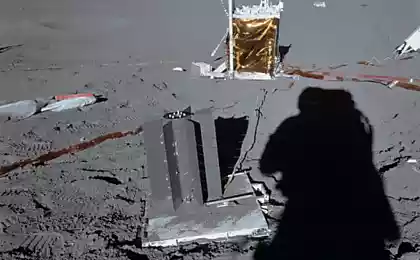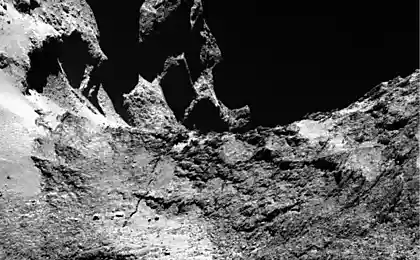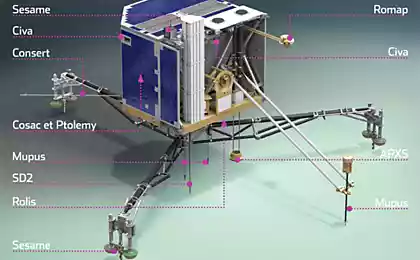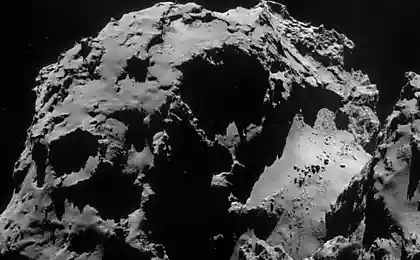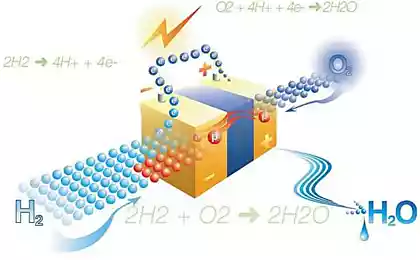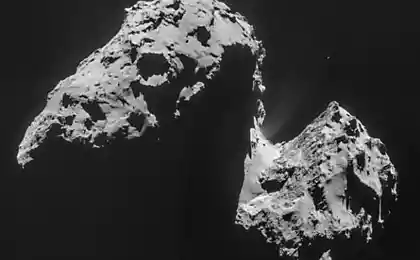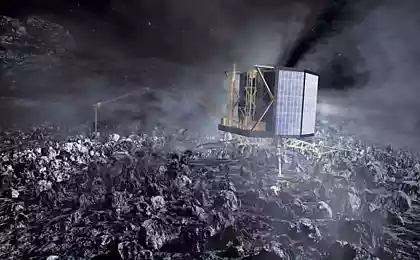1362
If at Philae was RTG
75,624,162
success of the program is clear: after 10 years of tracking the flight of the apparatus for the first time in history was made a soft landing on the surface of the comet. This is a definite triumph of space exploration. But it would be strange to expect that everything will go perfectly smoothly.
Reader, follow the news landing, knows , that some system device "Fila" not worked as expected. Harpoons for holding the probe on the surface were not thrown out, the problem was 0, 3 grams of nitrocellulose, which is not burning as expected. In 2013, the company Copenhagen Suborbitals показала, that the system is based on the substance in the vacuum of space is unreliable.
Do not load and a small rocket engine that was supposed to press the probe to the surface to secure the harpoon. The team, manage operations, did everything possible. But drilling surface and not much help: the comet material is not as soft as it was believed he was steadfast as ice.
The biggest problem is that the device is unlikely to be possible to use: need for electricity, and the sun barely shines on solar cells, "Fila", as he jumped from the surface and went into different from the predetermined point of the ESA. Charge your battery quickly extinguished, but the probe had to send home a lot of interesting information, including data on organic compounds in the atmosphere .
60 hours - almost sounds like a failure, when in fact the mission was successful. We are used to long periods of work rovers: they plow the surface of the red planet for months and even years, providing services sotsilnyh media beautiful photos and make headlines. "Spirit" after 6 years stuck in the sand. "Opportunity" Mars goes on for over 11 years. Its solar panels sweeps the sand, but the latest third-generation rover "Kyuriositi" is not terrible, it is possible due to the movement of radioisotope thermoelectric generators (RTGs).
RTG is placed inside the fuel, which can be a radioactive isotope with a suitable half-life and other parameters, such as the type of radiation. In the process of decay heat is generated, which is used by a thermocouple in a cylindrical shell of the container with the fuel.
Over the years, the RTG power will weaken, so it needs to do with the stock. At some point, the energy released will fall below acceptable levels - this technology also has its limits work. But still it is the best solution for powering autonomous spacecraft.
RTG unlike nuclear reactors, requires no control rods, a steam turbine, condenser and generator. Principles of operation of nuclear reactors and RTGs are somewhat different: not used a chain reaction, and natural decay.
Had to "Fila" stood RTGs, he could work out a lot longer than 60 hours, which had the charge of chemical batteries. But this is not all.
The desired landing point was well publicized. Not have to choose the point at which had the best relationship with the Earth, not the best geological site surface, not the flattest part of the comet. Sunlight largely added compromise situation. Had to "Fila" stood RTGs, the landing site could select and better.
Do not think that the device is not on the expected duration of work: in the world wanted to see how the comet approaches the sun begins to lose weight due to dust emission and evaporation of ice and gases. Now from the "Fila" we hardly know what breed lie under the surface, what is the structure of the ice. Over 60 hours was collected available data and sent home, but the probe was capable of more.
As помешалоиспользовать RTG design?
Yes, it would add to the weight, but not much. Kilograms of plutonium-238 produces about 500 watts of energy, much of which will remain warm, and has a half life of 87, 7 years. Works on the basis of this isotope RTG SNAP-9A, which began to use in space exploration in the sixties, produces 25 watts of power and has a mass of 12.3 kilograms. Surely now there is much more elegant and easy solutions. For comparison, the mass of the "Fila" - about 100 kg, it requires a comparable level of electrical energy.
Adding RTG could increase the overall cost of the mission, but she already billions and utility lander would have increased significantly. Over 10 years of flight "Rosetta" comet to power would fall slightly. Several times « leave » solar system "Voyager 1" also has RTG. It started in 1977, and then it worked at full capacity - 470 watts. In 2001 it had fallen to 315. The partial operation will last until 2025.
Plutonium-238 is not material for the production of atomic weapons. It radiates from the decay of alpha radiation, which can easily stop the protective screens. Therefore RTGs with this isotope used in the Apollo program during the landing on the moon.
55,272,279
Unfortunately, plutonium-238 in the world is not so much: after the end of the Cold War, it produces no more. Now the United States can begin to make a half a kilogram per year to NASA. Since 1993, the Russian side has fully provided the US space program, has sold 16, 5 kilograms of plutonium-238. But stocks decrease and self-life consideration. By estimated , start re US production will cost 75-90 million dollars, and for this may require five years. In the above estimations for the SNAP-9A RTG was about a kilo of this precious material. If we want to explore space, we clearly need a lot of this material is официальная NASA position .
In addition, the European Space Agency could hardly use such materials and technologies in their space program. But perhaps it is more organizational issues and cooperation with NASA or Russian companies could solve the problem.
The set of leaks of plutonium-238 is associated with failures of starting and operating the spacecraft. "Ulysses" RTG on board was launched without incident, but the study was conducted, the result of which was that if even on the launch pad was an explosion and the release of 11 kilograms of plutonium-238, the risk of cancer in the population increase would be negligible. In document literally says that with probability 0.0004% could be no more than 3 deaths. Plutonium-238 is stored in the form of silica, and it does not dissolve in water.
But the public remembers the Chernobyl nuclear disaster and Fukushima, so largely the cause does not lie in the technical constraints and in politics. It is because of politics and money "Fila" worked 60 hours, not years.
Source: geektimes.ru/post/241760/
success of the program is clear: after 10 years of tracking the flight of the apparatus for the first time in history was made a soft landing on the surface of the comet. This is a definite triumph of space exploration. But it would be strange to expect that everything will go perfectly smoothly.
Reader, follow the news landing, knows , that some system device "Fila" not worked as expected. Harpoons for holding the probe on the surface were not thrown out, the problem was 0, 3 grams of nitrocellulose, which is not burning as expected. In 2013, the company Copenhagen Suborbitals показала, that the system is based on the substance in the vacuum of space is unreliable.
Do not load and a small rocket engine that was supposed to press the probe to the surface to secure the harpoon. The team, manage operations, did everything possible. But drilling surface and not much help: the comet material is not as soft as it was believed he was steadfast as ice.
The biggest problem is that the device is unlikely to be possible to use: need for electricity, and the sun barely shines on solar cells, "Fila", as he jumped from the surface and went into different from the predetermined point of the ESA. Charge your battery quickly extinguished, but the probe had to send home a lot of interesting information, including data on organic compounds in the atmosphere .
60 hours - almost sounds like a failure, when in fact the mission was successful. We are used to long periods of work rovers: they plow the surface of the red planet for months and even years, providing services sotsilnyh media beautiful photos and make headlines. "Spirit" after 6 years stuck in the sand. "Opportunity" Mars goes on for over 11 years. Its solar panels sweeps the sand, but the latest third-generation rover "Kyuriositi" is not terrible, it is possible due to the movement of radioisotope thermoelectric generators (RTGs).
RTG is placed inside the fuel, which can be a radioactive isotope with a suitable half-life and other parameters, such as the type of radiation. In the process of decay heat is generated, which is used by a thermocouple in a cylindrical shell of the container with the fuel.
Over the years, the RTG power will weaken, so it needs to do with the stock. At some point, the energy released will fall below acceptable levels - this technology also has its limits work. But still it is the best solution for powering autonomous spacecraft.
RTG unlike nuclear reactors, requires no control rods, a steam turbine, condenser and generator. Principles of operation of nuclear reactors and RTGs are somewhat different: not used a chain reaction, and natural decay.
Had to "Fila" stood RTGs, he could work out a lot longer than 60 hours, which had the charge of chemical batteries. But this is not all.
The desired landing point was well publicized. Not have to choose the point at which had the best relationship with the Earth, not the best geological site surface, not the flattest part of the comet. Sunlight largely added compromise situation. Had to "Fila" stood RTGs, the landing site could select and better.
Do not think that the device is not on the expected duration of work: in the world wanted to see how the comet approaches the sun begins to lose weight due to dust emission and evaporation of ice and gases. Now from the "Fila" we hardly know what breed lie under the surface, what is the structure of the ice. Over 60 hours was collected available data and sent home, but the probe was capable of more.
As помешалоиспользовать RTG design?
Yes, it would add to the weight, but not much. Kilograms of plutonium-238 produces about 500 watts of energy, much of which will remain warm, and has a half life of 87, 7 years. Works on the basis of this isotope RTG SNAP-9A, which began to use in space exploration in the sixties, produces 25 watts of power and has a mass of 12.3 kilograms. Surely now there is much more elegant and easy solutions. For comparison, the mass of the "Fila" - about 100 kg, it requires a comparable level of electrical energy.
Adding RTG could increase the overall cost of the mission, but she already billions and utility lander would have increased significantly. Over 10 years of flight "Rosetta" comet to power would fall slightly. Several times « leave » solar system "Voyager 1" also has RTG. It started in 1977, and then it worked at full capacity - 470 watts. In 2001 it had fallen to 315. The partial operation will last until 2025.
Plutonium-238 is not material for the production of atomic weapons. It radiates from the decay of alpha radiation, which can easily stop the protective screens. Therefore RTGs with this isotope used in the Apollo program during the landing on the moon.
55,272,279
Unfortunately, plutonium-238 in the world is not so much: after the end of the Cold War, it produces no more. Now the United States can begin to make a half a kilogram per year to NASA. Since 1993, the Russian side has fully provided the US space program, has sold 16, 5 kilograms of plutonium-238. But stocks decrease and self-life consideration. By estimated , start re US production will cost 75-90 million dollars, and for this may require five years. In the above estimations for the SNAP-9A RTG was about a kilo of this precious material. If we want to explore space, we clearly need a lot of this material is официальная NASA position .
In addition, the European Space Agency could hardly use such materials and technologies in their space program. But perhaps it is more organizational issues and cooperation with NASA or Russian companies could solve the problem.
The set of leaks of plutonium-238 is associated with failures of starting and operating the spacecraft. "Ulysses" RTG on board was launched without incident, but the study was conducted, the result of which was that if even on the launch pad was an explosion and the release of 11 kilograms of plutonium-238, the risk of cancer in the population increase would be negligible. In document literally says that with probability 0.0004% could be no more than 3 deaths. Plutonium-238 is stored in the form of silica, and it does not dissolve in water.
But the public remembers the Chernobyl nuclear disaster and Fukushima, so largely the cause does not lie in the technical constraints and in politics. It is because of politics and money "Fila" worked 60 hours, not years.
Source: geektimes.ru/post/241760/
CANSONIC SKY - smart car system category Android Auto-shaped mirrors
Clever pan perfectly cook any dish
